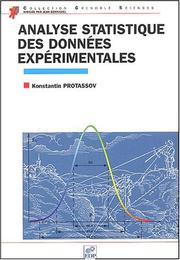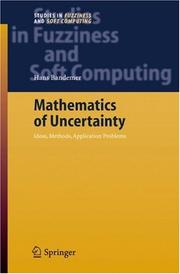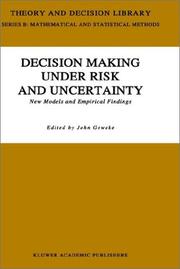| Listing 1 - 10 of 28 | << page >> |
Sort by
|
Book
Year: 1964 Publisher: New York, NY ; London : Academic Press,
Abstract | Keywords | Export | Availability | Bookmark
 Loading...
Loading...Choose an application
- Reference Manager
- EndNote
- RefWorks (Direct export to RefWorks)

ISBN: 2868835902 9782868835901 Year: 2002 Publisher: Les Ulis: EDP sciences,
Abstract | Keywords | Export | Availability | Bookmark
 Loading...
Loading...Choose an application
- Reference Manager
- EndNote
- RefWorks (Direct export to RefWorks)
Après une brève présentation des causes d'incertitudes, les distributions de probabilités les plus connues (Gauss, binomiale, Poisson) sont exposées. Ensuite, des notions plus complexes de statistique sont abordées : fonction d'une variable aléatoire, propagation des erreurs, échantillon, valeur moyenne et écart-type expérimentaux, distributions x2 et Student. Cette partie présente toute une panoplie d'outils nécessaires pour l'analyse approfondie des données expérimentales dans différentes situations (volume limité de données expérimentales, comparaisons des résultats, erreurs systématiques, etc.). Un chapitre spécial est consacré à l'ajustement des paramètres par la méthode des moindres carrés et par la méthode du maximum de vraisemblance. Des conseils pratiques sont donnés. Ils permettent d'améliorer les mesures et leur analyse. Cet ouvrage est destiné aux étudiants de second cycle universitaire et à tous les scientifiques et professionnels qui ont obtenu ce niveau. [Source : d'après la 4e de couverture]

ISBN: 3540284575 9786610427710 128042771X 3540312285 9783540284574 Year: 2006 Volume: 189 Publisher: Berlin ; London : Springer,
Abstract | Keywords | Export | Availability | Bookmark
 Loading...
Loading...Choose an application
- Reference Manager
- EndNote
- RefWorks (Direct export to RefWorks)
"Mathematics of Uncertainty" provides the basic ideas and foundations of uncertainty, covering the fields of mathematics in which uncertainty, variability, imprecision and fuzziness of data are of importance. This introductory book describes the basic ideas of the mathematical fields of uncertainty from simple interpolation to wavelets, from error propagation to fuzzy sets and neural networks. The book presents the treatment of problems of interpolation and approximation, as well as observation fuzziness which can essentially influence the preciseness and reliability of statements on functional relationships. The notions of randomness and probability are examined as a model for the variability of observation and measurement results. Besides these basic ideas the book also presents methods of qualitative data analysis such as cluster analysis and classification, and of evaluation of functional relationships such as regression analysis and quantitative fuzzy data analysis.
Book
Year: 1962 Publisher: Englewood Cliffs, N.J. : Prentice-Hall,
Abstract | Keywords | Export | Availability | Bookmark
 Loading...
Loading...Choose an application
- Reference Manager
- EndNote
- RefWorks (Direct export to RefWorks)
Book
ISBN: 1527534693 9781527534698 1527527107 9781527527102 Year: 2019 Publisher: Newcastle Upon Tyne, England : Cambridge Scholars Publishing,
Abstract | Keywords | Export | Availability | Bookmark
 Loading...
Loading...Choose an application
- Reference Manager
- EndNote
- RefWorks (Direct export to RefWorks)
This book discusses entropy and the Second Law of Thermodynamics in such a way that everyone can understand its subject matter. Entropy is one of the most interesting concepts in physics. Although it is a well-defined concept, it is still perceived by even well-known scientists as a concept cloaked in mystery. It is also the most misused, and often abused, concept in physics. In order to understand entropy, one needs to understand the Shannon measure of information, and in order to grasp this idea, one must be familiar with some basic concepts of probability. Therefore, this book consists of three chapters: the first discusses probability, the second addresses Information Theory, and the third considers entropy and the Second Law of Thermodynamics. Readers will discover that the Second Law is nothing but a law of probability.
Entropy. --- Entropy --- Thermodynamics --- Information theory --- Uncertainty (Information theory) --- Entropie --- Thermodynamique --- Information, Théorie de l' --- Incertitude (théorie de l'information) --- Study and teaching. --- Étude et enseignement
Book

ISBN: 2759219062 9782759219063 Year: 2013 Publisher: Versailles : Quae,
Abstract | Keywords | Export | Availability | Bookmark
 Loading...
Loading...Choose an application
- Reference Manager
- EndNote
- RefWorks (Direct export to RefWorks)
Book
ISBN: 9781108478359 9781108745741 9781108777513 Year: 2021 Publisher: Cambridge, UK : Cambridge University Press,
Abstract | Keywords | Export | Availability | Bookmark
 Loading...
Loading...Choose an application
- Reference Manager
- EndNote
- RefWorks (Direct export to RefWorks)
Build the skills for determining appropriate error limits for quantities that matter with this essential toolkit. Understand how to handle a complete project and how uncertainty enters into various steps. Provides a systematic, worksheet-based process to determine error limits on measured quantities, and all likely sources of uncertainty are explored, measured or estimated. Features instructions on how to carry out error analysis using Excel and MATLAB, making previously tedious calculations easy. Whether you are new to the sciences or an experienced engineer, this useful resource provides a practical approach to performing error analysis. Suitable as a text for a junior or senior level laboratory course in aerospace, chemical and mechanical engineering, and for professionals.
Book
ISBN: 2130475841 9782130475842 Year: 1996 Volume: 3110 Publisher: Paris: PUF,
Abstract | Keywords | Export | Availability | Bookmark
 Loading...
Loading...Choose an application
- Reference Manager
- EndNote
- RefWorks (Direct export to RefWorks)
Artificial intelligence. Robotics. Simulation. Graphics --- Probability theory --- Artificial intelligence --- Uncertainty (Information theory) --- Knowledge representation (Information theory) --- Intelligence artificielle --- Incertitude (Théorie de l'information) --- Représentation des connaissances --- Intelligence artificielle. --- Ensembles flous --- Artificial intelligence. --- Incertitude (Théorie de l'information) --- Représentation des connaissances
Book
ISBN: 0720433142 0444103783 9780720433142 Year: 1972 Volume: v. 14 Publisher: Amsterdam: North-Holland,
Abstract | Keywords | Export | Availability | Bookmark
 Loading...
Loading...Choose an application
- Reference Manager
- EndNote
- RefWorks (Direct export to RefWorks)
Statistical science --- Social sciences --- Distribution (Probability theory) --- Uncertainty (Information theory) --- Statistical methods --- Methodology --- 519.2 --- Probability. Mathematical statistics --- 519.2 Probability. Mathematical statistics --- Sciences sociales --- Incertitude (Théorie de l'information) --- Méthodologie --- Méthodes statistiques --- Social sciences - Statistical methods --- Social sciences - Methodology --- Statistique --- Modeles mathematiques

ISBN: 0792319044 9401052611 9401128383 Year: 1992 Volume: 22 Publisher: Dordrecht : Kluwer academic,
Abstract | Keywords | Export | Availability | Bookmark
 Loading...
Loading...Choose an application
- Reference Manager
- EndNote
- RefWorks (Direct export to RefWorks)
Decision making --- Risk --- Uncertainty (Information theory) --- Prise de décision --- Incertitude (Théorie de l'information) --- Mathematical models --- Congresses --- Modèles mathématiques --- Congrès --- Congresses. --- Prise de décision --- Incertitude (Théorie de l'information) --- Modèles mathématiques --- Congrès --- Decision-making - Mathematical models - Congresses. --- Risk - Mathematical models - Congresses. --- Uncertainty (Information theory) - Congresses.
| Listing 1 - 10 of 28 | << page >> |
Sort by
|

 Search
Search Feedback
Feedback About UniCat
About UniCat  Help
Help News
News